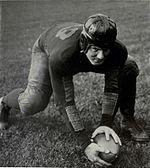History of Michigan Wolverines football in the Kipke years
During the nine years in which Kipke served as head football coach, Michigan claimed two national championships (1932 and 1933) and had an additional undefeated season in 1930.
[1] Two weeks later, in June 1929, Yost announced that Harry Kipke had been hired as Michigan's new head football coach.
[2] Kipke had been an All-American halfback on Yost's Michigan football teams from 1921 to 1923 and had developed a reputation as one of the best punters in the game.
With Kipke in place, Yost announced that he was stepping aside and thereafter would "act solely as an interested spectator" unless his advice was sought.
[4] Kipke retained Jack Blott, Franklin Cappon, Cliff Keen, Bennie Oosterbaan, and George F. Veenker as assistant coaches.
[14][15] Four Wolverines were named first-team All-Big Ten players – Morrison, Harry Newman, Ivy Williamson, and Bill Hewitt.
[13] In 1932, Michigan compiled a perfect 8–0 record, outscored opponents 123–12, and won both the Big Ten Conference and national championships.
[16] Although there was no AP Poll to determine a national champion in 1932, the Knute K. Rockne Trophy was presented at the end of the season to the team deemed to be the national champion using the Dickinson System, a rating system developed by Frank G. Dickinson, a professor of economics of the University of Illinois.
The Associated Press wrote, "Without Newman providing the winning spark, the Michigan team might have been just another football club.
[25] Gerald Ford, who later became the 38th President of the United States, was the back-up center on the team and won the Meyer Morton Award as the most improved player in spring practice.
[27][28] By winning a share of its fourth consecutive Big Ten football championship, the 1933 Wolverines also tied a record set by Fielding H. Yost's "Point-a-Minute" teams from 1901 to 1904.
[26] In the second half, Michigan outscored its opponents 30 to 12 and defeated Illinois, 7–6, with the difference being Willis Ward's block of an extra point kick.
[33] Center Chuck Bernard and tackle Francis Wistert were consensus first-team picks for the 1933 College Football All-America Team.
[45] Kipke actively recruited Willis Ward to Michigan and assured him that he would be given full opportunity to play football as well as compete in track.
[48][49] In November 1933, Time magazine credited Ward and halfback Herman Everhardus for Michigan's undefeated season.
[45][53][54] Time magazine reported that 200 "campus radicals" threatened to prevent the game from being played by standing in the middle of the field.
[53] Playwright Arthur Miller, then a writer for Michigan's student newspaper arranges a meeting with Georgia Tech players and appealed to their sense of fair play.
The Georgia Tech players rebuffed "the Yankee" Miller "in salty language" and told him they would actually kill Ward if he set foot on the Michigan gridiron.
Ward and Ford met during freshman orientation in 1932, and the two became friends and roommates when the football team traveled for road games.
Kipke expressed shock at the decision, noting that he had expected a "splendid season" in 1938 based on the performance of 1937's freshman squad which included Tom Harmon, Forest Evashevski, Reuben Kelto, and Ralph Fritz.
Ralph W. Aigler, a law professor and chairman of Michigan's Faculty Board in Control of Athletics since 1917, was one of the first persons within the University to challenge Yost's authority.
[63] On February 10, 1938, Aigler made a public announcement that Fritz Crisler had been hired as Michigan's new head football coach.
[66] During the Kipke years, Michigan compiled a 4-4-1 record in its annual Little Brown Jug rivalry game with the Minnesota Golden Gophers.
Bierman's teams played Michigan to a scoreless tie in 1933 and then won nine straight games against the Wolverines, extending from 1934 to 1942.
The tradition of having the two programs conclude their seasons with the rivalry game began in 1935, with Ohio State defeating Michigan 38–0 in Ann Arbor.
[71] Ten days after the record-setting crowd attended the Ohio State game, the stock market crash of 1929 struck on Black Tuesday.
The electronic scoreboards, installed at both ends, were controlled from a switchboard in the press box and displayed the score, downs, yards to go, and other information on a current basis.










